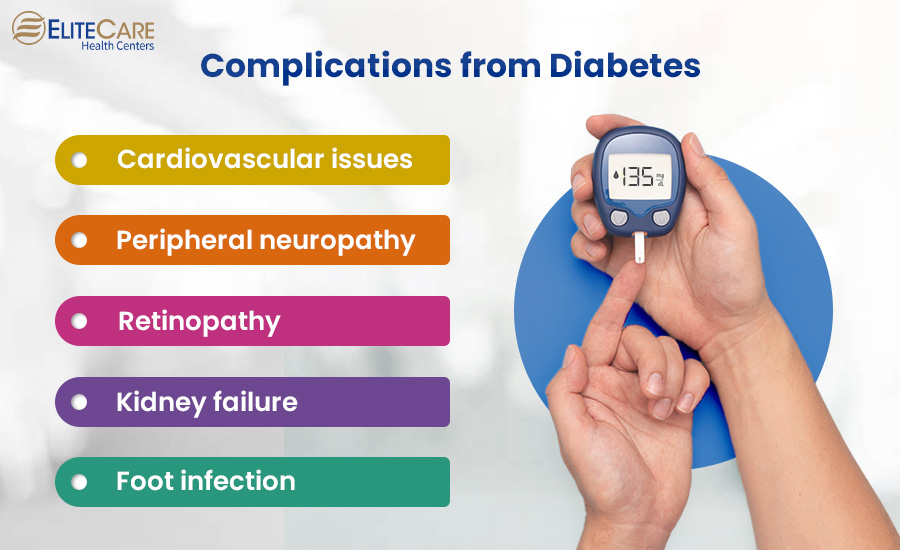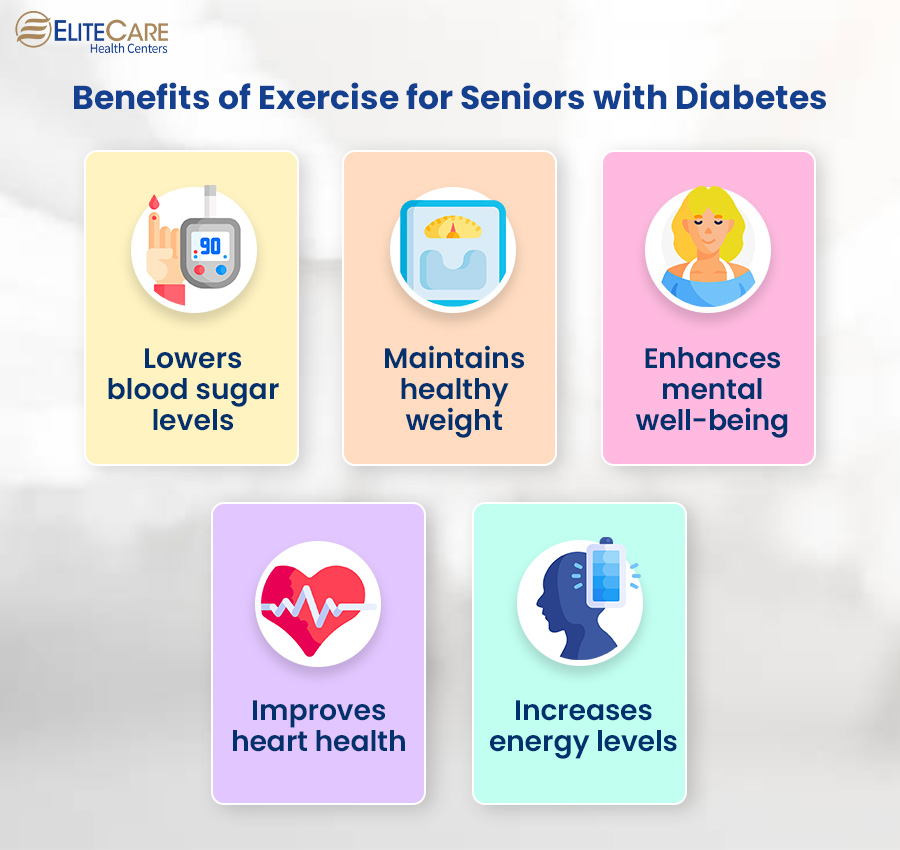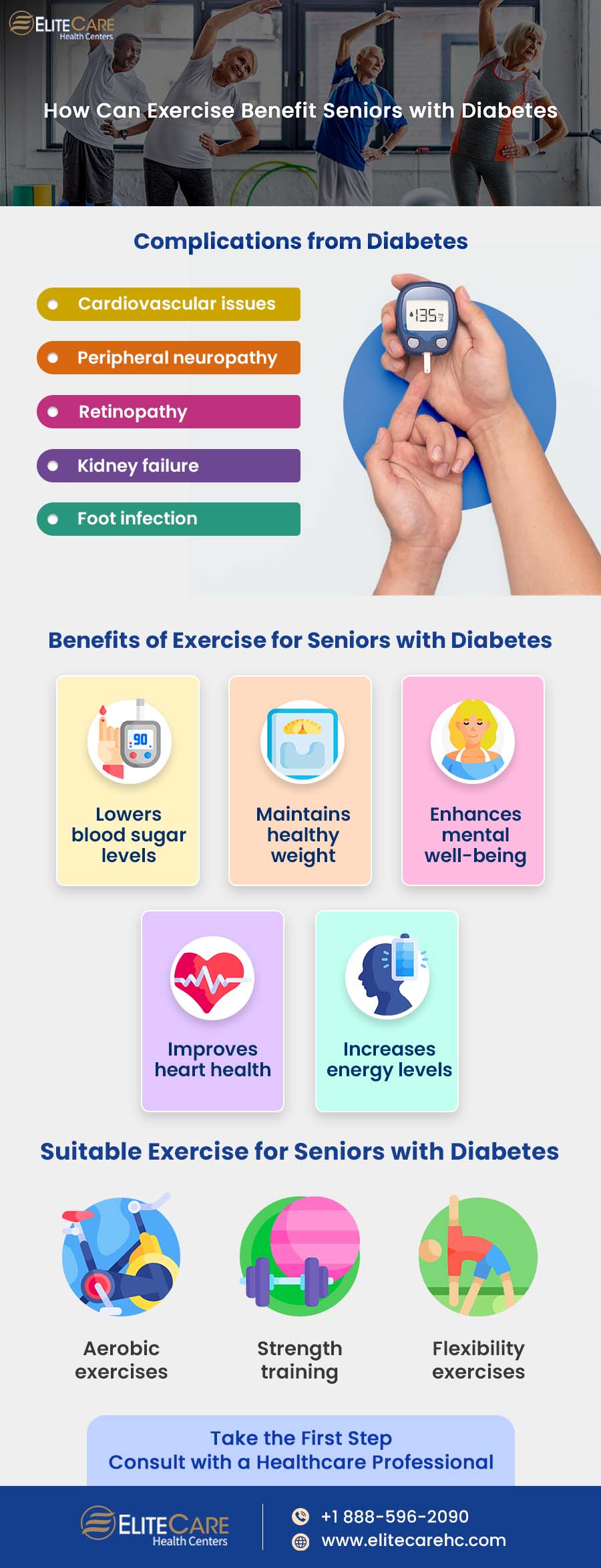
As we age, prioritizing our physical and mental well-being becomes increasingly important, especially for individuals managing chronic conditions. For seniors with diabetes, maintaining good health is crucial, and regular exercise plays an essential role in managing their condition and enhancing overall well-being. However, they often encounter unique challenges that can hinder their ability to engage in physical activity and effectively maintain their health. In recognition of these challenges, this blog post aims to provide valuable insights into the benefits of exercise specifically tailored for seniors with diabetes.
Understanding Diabetes in Seniors
Diabetes is a chronic metabolic disorder characterized by high blood sugar levels. It affects the body’s ability to produce or utilize insulin, a hormone that regulates blood sugar. According to the American Diabetes Association, more than 25% of individuals aged 65 or older have diabetes. Diabetes is a prevalent health concern among seniors. Making regular visits to a medical clinic or healthcare center is crucial for diabetes management.
Types of Diabetes that Affect Seniors
Type 2 Diabetes
This is the most common type of diabetes among seniors. It occurs when the body becomes resistant to the effects of insulin, resulting in elevated blood sugar levels. Obesity, sedentary lifestyle, and genetic predisposition contribute to its development.
Type 1 Diabetes
Although less common in seniors, Type 1 diabetes can still occur later in life. It is an autoimmune condition where the body’s immune system mistakenly attacks and destroys insulin-producing cells in the pancreas. Seniors with Type 1 diabetes require insulin therapy to manage their blood sugar levels.
Gestational Diabetes
This type of diabetes develops during pregnancy and can affect older women who become pregnant. It usually resolves after delivery, but it increases the risk of developing Type 2 diabetes later in life.
Diabetes Complications

1. Cardiovascular Problems
Diabetes increases seniors’ risk of heart disease, stroke, and high blood pressure.
2. Neuropathy
Nerve damage caused by diabetes leads to tingling, numbness, and pain, particularly in the feet and hands.
3. Retinopathy
Diabetes can affect the blood vessels in the eyes, leading to vision problems and even blindness if left uncontrolled.
4. Kidney Disease
A leading cause of kidney disease, diabetic nephropathy, can lead to kidney failure.
5. Foot Problems
Poor blood circulation and nerve damage can result in foot ulcers and infections, which can be severe for seniors.
By understanding these aspects, it becomes evident that exercise is crucial for the well-being of an individual with diabetes, as exercise routine can help minimize the risk of complications and maximize the benefits of physical activity.
Benefits of Exercise for Seniors with Diabetes

Medical clinics often recommend exercise as an essential component of diabetes management. Here are some benefits of regular exercise for a diabetic patient:
1. Lowers Blood Sugar Levels
Physical activity helps lower blood sugar levels by increasing insulin sensitivity, allowing the body to use insulin more effectively. Exercise also helps cells take in glucose for energy, reducing reliance on insulin. Regular exercise can also decrease insulin resistance, a common issue in type 2 diabetes.
2. Weight Management
Exercise burns calories, maintains a healthy weight, and reduces excess body fat. It also enhances insulin sensitivity, allowing cells to effectively utilize glucose for energy, which regulates blood sugar levels. Alongside exercise, a balanced diet focusing on nutrient-rich foods, portion control, and minimizing processed and sugary foods supports weight management and stable blood sugar control.
3. Improves Cardiovascular Health
Incorporating regular exercise can help strengthen the heart, enhancing blood circulation, lowering blood pressure, and ultimately reducing the potential cardiovascular complications.
4. Positive Impact on Mental Well-being
Physical activity releases endorphins, which are natural mood-boosting hormones, promoting feelings of happiness and reducing stress and anxiety. Seniors with diabetes often face emotional and psychological challenges, and exercise can be a powerful tool in enhancing mental well-being.
5. Increased Energy and Mobility
Seniors with diabetes may experience reduced energy levels and mobility due to their condition, but exercise helps counteract these effects. Regular exercise improves muscle strength and endurance, enhancing overall physical performance and mobility. Exercise can also improve balance and create greater independence in daily activities.
Safety Measures and Precautions
Important considerations that must be kept in mind before starting an exercise routine are as follows:
1. Consult with Healthcare Professionals
Seniors with diabetes must consult with their healthcare team, either through an online doctor consultation or at a healthcare center, before starting an exercise program. Healthcare professionals at certain medical clinics can assess individual health conditions, provide guidance on appropriate exercise intensity and duration, and address specific concerns or limitations.
2. Blood Sugar Monitoring
Monitoring blood sugar levels before, during, and after exercise is essential for seniors with diabetes. By regularly checking their blood sugar levels with lancet device, seniors can ensure they are within a safe range and make any necessary adjustments to insulin or medication doses. This proactive approach helps prevent the occurrence of hypoglycemia (low blood sugar) or hyperglycemia (high blood sugar). It is crucial for seniors to work closely with their primary care physician to determine if any modifications to their insulin or oral medications are needed in order to prevent hypoglycemia and maintain stable blood sugar levels during exercise.
3. Customizing Fitness Exercise
Seniors may have physical limitations or co–existing conditions that may require specific exercise routine. It is important to consider these factors and modify exercises accordingly. For example, individuals with joint problems can opt for low-impact exercises like swimming or cycling. It is best to consult with a healthcare provider or a trained fitness professional.
4. Hydration and Rest
Staying hydrated during exercise is essential, especially for seniors with diabetes. Ensure an adequate intake of fluids before, during, and after the exercise session. Additionally, allow for sufficient rest periods between exercises or sessions to prevent excessive fatigue.
5. Avoid Extreme Weather Condition
Exercise in extreme heat or cold should be avoided or modified to prevent overheating, dehydration, or adverse effects on blood sugar levels. Seek indoor exercise alternatives or plan outdoor activities during milder times of the day.
6. Foot Care
Diabetes can cause poor circulation and nerve damage, so proper foot care is essential. Wear proper footwear, check for any injuries or blisters before and after exercise, and maintain good foot hygiene.
By considering these factors and seeking professional guidance, seniors with diabetes can exercise safely, adapt exercises to their needs, and minimize the risk of complications.
Suitable Exercises for Seniors with Diabetes

When it comes to exercise for seniors with diabetes, it is important to consider their individual physical capabilities and health conditions. Customizing exercise routines based on these factors ensures a safe and effective approach. Different types of exercise that can be suitable for seniors with diabetes includes:
1. Aerobic Exercises
Also known as cardiovascular exercises, they promote heart health, improve blood circulation, and help manage blood sugar levels. Examples of aerobic exercises suitable for seniors with diabetes include:
– Walking: Start with shorter walks and gradually increase duration and intensity.
– Swimming: A gentle and joint-friendly exercise that provides a full-body workout.
– Cycling: Outdoors or on a stationary bike, cycling is a low-impact exercise that strengthens the legs and improves cardiovascular fitness.
– Dancing: Combines aerobic exercise with rhythm and coordination. Joining dance classes or simply dancing at home can be an enjoyable way to get moving.
Read More: 12 Benefits of Dancing for Seniors
2. Strength Training
Strength training exercises help build muscle strength, improve bone density, and increase metabolism. Examples of strength training exercises are as follows:
– Bodyweight Exercises: Squats, lunges, push-ups, and wall sits- which help strengthen major muscle groups. These can be performed at home or in a gym.
– Resistance Band Exercises: Resistance bands can provide resistance training without needing heavy weights. Exercises like bicep curls, shoulder presses, and leg extensions can be performed with bands of varying resistance.
– Weight Machines or Free Weights: If accessible, weight machines or free weights can be incorporated into strength training routines. Working with a trainer or healthcare professional can ensure proper form and safety.
3. Flexibility Exercises
Also known as stretching exercises, they are crucial for improving joint mobility, posture, and balance, while reducing the risk of injuries. These exercises hold particular significance for individuals with diabetes, as the condition can impact circulation and joint health. Examples of flexibility exercises suitable for seniors with diabetes include:
– Stretching: Perform static stretches that target major muscle groups. Focus on stretching the calves, hamstrings, quadriceps, shoulders, and back.
– Yoga or Pilates: These activities combine stretching, balance, and strength training and help relieve stress.
Read More: Why Should Seniors Practice Yoga?
Is a Warmup & Cool Down Necessary?
Warm-up exercises prepare the body for physical activity by gradually increasing the heart rate and warming the muscles. Examples of warm-up exercises include gentle movements, marching in place, or light stretching.
Similarly, cool-down exercises are essential after the main exercise session. They gradually lower the heart rate; help prevent muscle soreness and aid recovery. Cool-down exercises can involve gentle stretches and deep breathing exercises.
It is advisable to consult with professionals from health care clinics or senior care services for personalized exercise recommendations and guidance based on individual health conditions and goals.
Take – Away
Being physically active is important for seniors with diabetes in managing their condition and improving overall health.
EliteCare Health Center supports seniors on their journey towards better health. Our healthcare professionals can provide guidance and recommendations tailored to individual needs through routine physical exams and personalized consultations. Our primary care physicians can help seniors with diabetes create safe and effective exercise routines aligning with their health conditions, goals, and limitations. Take control of your health today by incorporating exercise into your routine.






